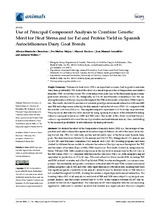Mostrar el registro sencillo del ítem
Use of Principal Component Analysis to Combine Genetic Merit for Heat Stress and for Fat and Protein Yield in Spanish Autochthonous Dairy Goat Breeds
| dc.contributor.author | Menéndez-Buxadera, A. | |
| dc.contributor.author | Muñoz Mejías, Eva | |
| dc.contributor.author | Sánchez-Rodríguez, M. | |
| dc.contributor.author | Serradilla Manrique, J.M. | |
| dc.contributor.author | Molina, Antonio | |
| dc.date.accessioned | 2021-03-08T12:32:35Z | |
| dc.date.available | 2021-03-08T12:32:35Z | |
| dc.date.issued | 2021 | |
| dc.identifier.uri | http://hdl.handle.net/10396/21151 | |
| dc.description.abstract | We studied the effect of the Temperature Humidity Index (THI) (i.e., the average of temperature and relative humidity registered at meteorological stations) closest to the farms taken during the test day (TD), for total daily protein and fat yields (fpy) of the three main Spanish dairy goats. The data were from Florida (11,244 animals and 126,825 TD), Malagueña (12,215 animals and 141,856 TD) and Murciano Granadina (5162 animals and 62,834 TD) breeding programs and were studied by different linear models to estimate the nature of the fpy response throughout the THI and the weeks of lactation (Days in Milk, DIM) trajectories. The results showed an antagonism between THI and DIM, with a marked depression in the fpy level in animals kept in the hot zone of the THI values (THI > 25) compared with those in the cold zone (THI ≤ 16), with a negative impact equivalent to production of 13 to 30 days. We used a Reaction Norm model (RN), including THI and DIM as fixed covariates and a Test Day Model (TDM), to estimate the genetic (co)variance components. The heritability and genetic correlations estimated with RN and TDM showed a decreased pattern along the scale of THI and DIM, with slight differences between breeds, meaning that there was significant genetic variability in the animal’s ability to react to different levels of THI, which is not constant throughout the DIM, showing the existence of genotype-environment interaction. The breeding values (BV) of all animals for each level of THI and DIM were subject to a principal component analysis, and the results showed that 89 to 98% of the variance between the BV was explained by the two first eigenvalues. The standardized BV were weighted with the corresponding eigenvector coefficients to construct an index that showed, in a single indicator, the most complete expression of the existing genetic variability in the animals’ ability to produce fpy along the trajectories of THI and DIM. This new option will make it easier to select animals which are more productive, and with better adaptability to heat stress, as well as enabling us to exploit genetic variations in the form of the response to heat stress to be adapted to different production systems. | es_ES |
| dc.format.mimetype | application/pdf | es_ES |
| dc.language.iso | eng | es_ES |
| dc.publisher | MDPI | es_ES |
| dc.rights | https://creativecommons.org/licenses/by/4.0/ | es_ES |
| dc.source | Animals 11(3), 736 (2021) | es_ES |
| dc.subject | Dairy goat | es_ES |
| dc.subject | Heat stress | es_ES |
| dc.subject | Random regression model | es_ES |
| dc.title | Use of Principal Component Analysis to Combine Genetic Merit for Heat Stress and for Fat and Protein Yield in Spanish Autochthonous Dairy Goat Breeds | es_ES |
| dc.type | info:eu-repo/semantics/article | es_ES |
| dc.relation.publisherversion | http://dx.doi.org/10.3390/ani11030736 | es_ES |
| dc.relation.projectID | Gobierno de España. RTA2015‐00035‐C03‐03 | es_ES |
| dc.rights.accessRights | info:eu-repo/semantics/openAccess | es_ES |

